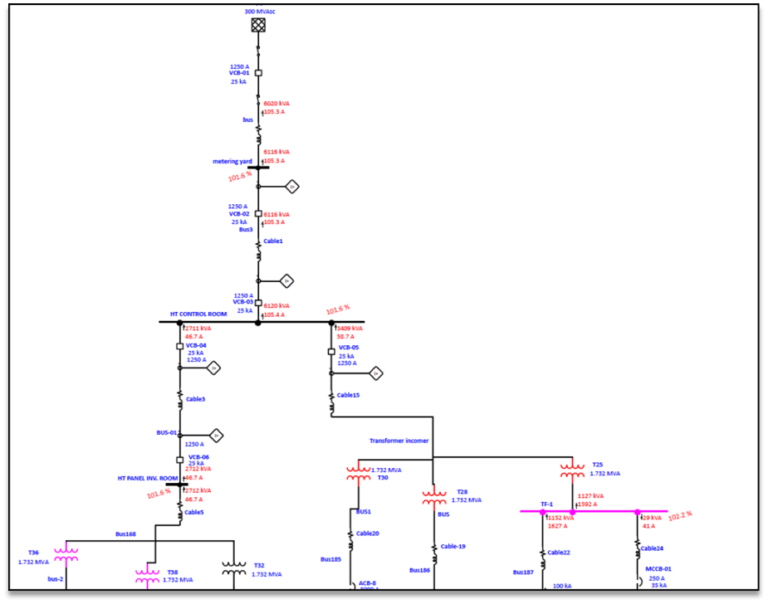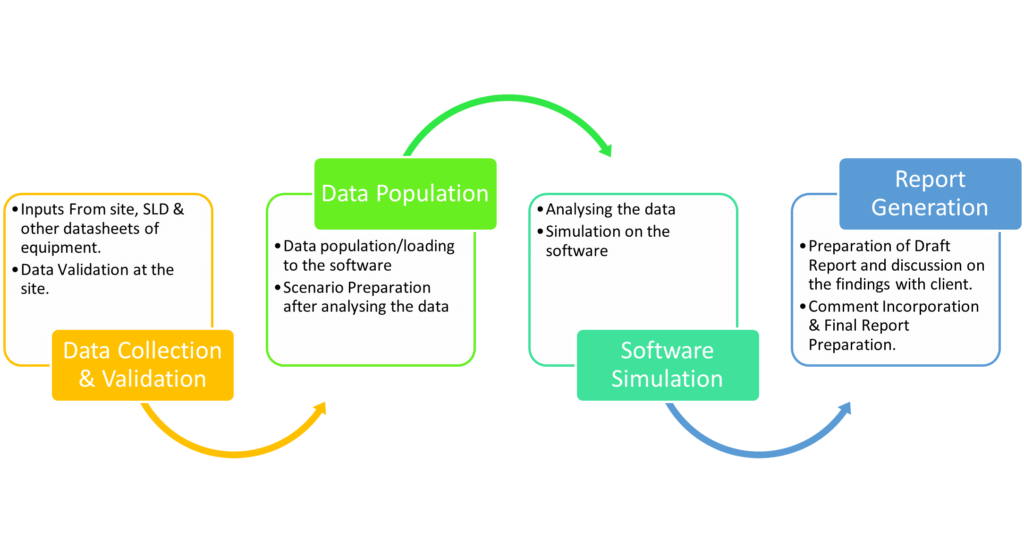Load Flow Study
Unleash the power of your electrical network with our comprehensive Load Flow Study services. Wire Consultancy empowers businesses to achieve optimised voltage levels, efficient load distribution, and enhanced energy management. Our team of skilled electrical engineers and advanced techniques ensures accurate simulations and insightful analysis, enabling you to make informed decisions for your power system’s reliability and performance. Enhance your operations and minimise disruptions with our specialised Load Flow Study services.
We Strive to Drive
Engineering & Design

Load Flow Study
In electrical engineering and power systems, ensuring a stable and reliable power supply is paramount. To achieve this, power utilities, engineers, and operators rely on a crucial tool known as the Load Flow Study, also called Power Flow Analysis. This comprehensive study plays a pivotal role in analysing, optimizing, and maintaining the steady-state operation of power systems. In this article, we will delve into the significance of Load Flow Studies, their objectives, and how they contribute to the efficient functioning of electrical grids.
A Load Flow Study is an in-depth analysis of an electrical power system, encompassing generators, transmission lines, transformers, distribution lines, and loads.

Its primary objective is to calculate critical electrical parameters, such as voltage magnitudes, voltage angles, active power (real power), and reactive power flows throughout the entire power network. By simulating the complex interactions between these components, the study helps to identify potential issues, plan for contingencies, and ensure the overall reliability of the power system.
Software & Simulation Tools
Conducting Load Flow Studies requires sophisticated computational algorithms to solve the complex power flow equations. The most widely used method is the Newton-Raphson algorithm, which iteratively calculates the power flow across the network. Advanced power system analysis software and simulation tools have made these calculations more efficient and accurate.
Some of the tools we are using at WIRE CONSULTANCY are as follows :- ETAP, DIGSILENT, PSSE by Siemens.
Standard Reference to Perform Load flow Study
1.IEEE 399-1997 – IEEE Recommended Practice for Industrial and Commercial Power Systems Analysis
2.IEEE 3002.2-2018 – IEEE Recommended Practice for Conducting Load-Flow Studies and Analysis of Industrial and Commercial Power Systems
Objectives of Load Flow Study
- Voltage Profile Analysis: One of the primary objectives of a Load Flow Study is to determine the voltage levels at all nodes within the power system. Maintaining proper voltage levels is crucial to prevent equipment failure, ensure optimal performance, and provide a stable power supply to consumers. Voltage levels that are too high or too low can lead to inefficiencies, overheating of devices, and even blackouts.
- Power Loss Calculation: Load Flow Studies calculate the power losses that occur during the transmission and distribution of electrical power. Identifying and minimizing these losses is vital to enhance the overall efficiency of the power system. Reducing power losses translates to cost savings and a more sustainable energy distribution network.
- Reactive Power Control: Proper control of reactive power is essential to maintain voltage stability. A Load Flow Study evaluates the need for reactive power compensation devices such as capacitors and reactors to regulate voltage levels and improve the power factor. By optimizing reactive power flow, power utilities can reduce energy wastage and enhance voltage stability.
- Load Balancing: Maintaining a balanced power system is crucial to ensure that the power generation matches the demand at all locations. Load Flow Studies help identify potential areas of overload, allowing for better resource planning and allocation. This ensures that equipment is not strained and the power supply remains uninterrupted.
- Contingency Analysis: The power grid is susceptible to various contingencies, including equipment failures, sudden changes in power demand, or natural disasters. Load Flow Studies perform contingency analysis to assess the system’s response to these events. By identifying potential vulnerabilities, power utilities can develop robust contingency plans to ensure uninterrupted power supply during emergencies.
How to Perform the Load Flow Study
The following Methodology is being followed to perform load flow analysis study.

Conclusion
In conclusion, Load Flow Studies serve as a crucial service in the kingdom of electrical engineering, providing power utilities, engineers, and operators with critical insights to optimize power system performance. By understanding the voltage profile, controlling power losses, managing reactive power, and analysing contingencies, Load Flow Studies ensure a stable, reliable, and efficient power supply to consumers.
Similar Services
Contact
Feel free to contact us for any questions and query
Connecting with Us is Just a Click Away – Let’s Begin Your Project Hassle Free.
Our team of experienced consultants is ready to collaborate with you to achieve your engineering, safety and sustainability goals. Get in touch with us to learn more.
Our Offices
Noida Office
Office-03, First Floor, D-53, Sector-2,
Noida, Uttar Pradesh-201301, India
For Business Enquiry
Info@wireconsultants.com
+91-9810827158
For HR Enquiry
hr@wireconsultants.com
+91-7827931701
Copyright © 2023 Wire Consultancy | All Rights Reserved
